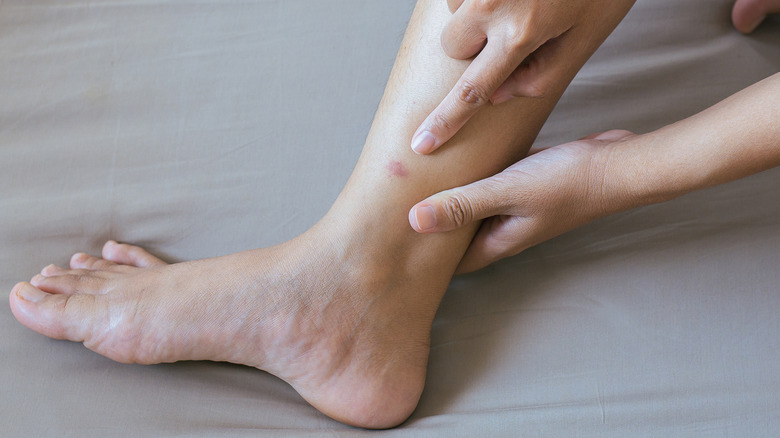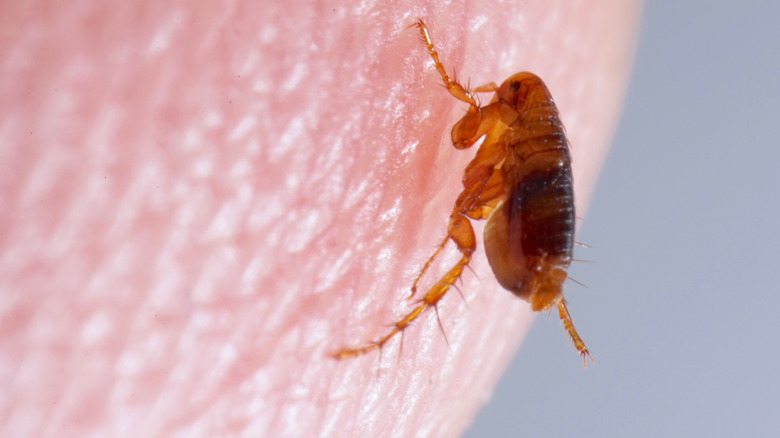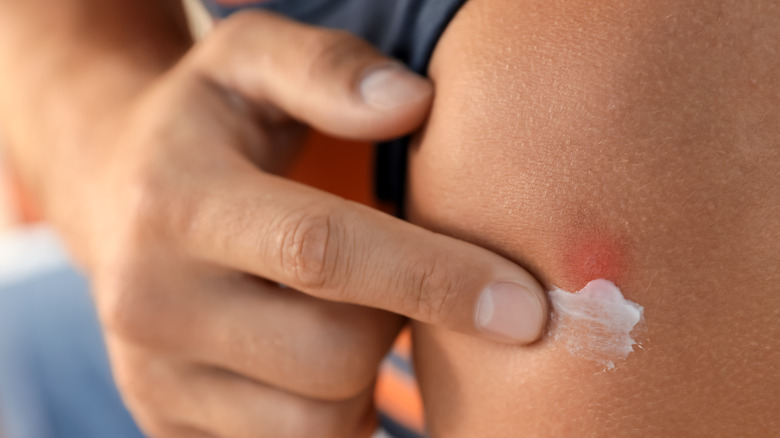What It Means When A Flea Bite Turns Into A Blister
It's not a tick and it's not a gnat. Rather, it's another tiny critter that's easy to miss if you're not looking for it: fleas. While just one of these insects may appear harmless enough on its own, when it comes to fleas, there's strength in numbers. So much so, that an infestation can be hard to control once it starts, according to PestWorld.org. Often brought into our homes by pets and rodents, an adult female flea is estimated to produce as many as 2,000 eggs over the course of their life (via Only Natural Pet). That's a lot of fleas to be found nestled in one's furniture, bedding, or carpets.
With three pairs of legs, these jumping insects measure in at only about one-eighth of an inch fully grown, reports PestWorld.org. What fleas lack in size, however, they make up for in bite — and we're not only referring to your pets. Fleas can also feast on humans, leaving behind an uncomfortably sore, itchy, or painful bite mark (per Healthline).
Signs of infection or hypersensitivity to flea bites
Should you be bitten by a flea, you'll likely find their bite marks on specific areas of the body, such as the ankles, waist, legs, or on the insides of the knees or elbows, reports Healthline. Their defining feature is their patterning. These small, red bites can be found in bunches of three or four, or following a straight line. In some instances, flea bites may also be surrounded by a faint, red halo.
In some cases, however, you may notice a flea bite developing into a blister. Healthline explains this can occur as a result of scratching the site. Specifically, a blister with a white top may indicate an infection. Alternatively, those with hypersensitivity to insect bites may develop what's known as bullae, according to NiDirect Government Services. Although less common, bullae are large blisters filled with fluid. This hypersensitivity to insect bites — including flea bites — was one diagnostic theory proposed by Dr. Ted Rosen, Professor of Dermatology at Baylor College of Medicine, for an elderly patient experiencing three days' worth of blistering on her foot after spending time gardening outdoors (via Patient Care).
Treatment for flea bites
Thankfully, the irritation of a flea bite is usually relatively short-lived. According to Cleveland Clinic, the bites often heal on their own within a matter of days and normally do not require professional medical care. At-home treatment methods include the use of antihistamines or over-the-counter (OTC) topical anti-itch products to help reduce pain or itching. Applying a cold compress, such as ice wrapped in a towel, can also be helpful to keep swelling and discomfort at a minimum.
Alternatively, certain natural remedies may also help soothe irritated skin. Experts at the Cleveland Clinic say this can be achieved by applying honey or aloe vera to the bite area. Alternatively, apply a damp chamomile tea bag or a colloidal oatmeal mixture to the site for a period of 10 minutes before cleaning it off. However, in the event of infection, fever, an allergic reaction, or body aches, further treatment for a flea bite may be required. If you experience any of these additional symptoms, be sure to reach out to your physician.



